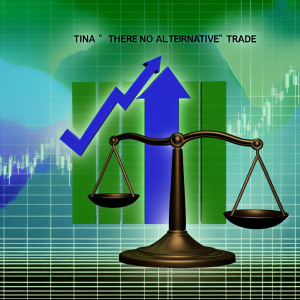Wall Street’s latest moves are teaching a timeless lesson: the grass is never truly greener on the other side. After a tumultuous start to the year marked by trade war jitters and a significant rotation out of U.S. equities, major players like Goldman Sachs and Bank of America are now revising their year-end targets for the S&P 500 upward. This pivot signals a potential overcorrection earlier in the year and a renewed confidence in American stocks.
The buzzword on Wall Street this year has been the TACO Trade—an acronym capturing the allure of tech, automation, cloud, and online services. Yet, alongside this newcomer, an old favorite is making a comeback: TINA, or “There Is No Alternative” to U.S. equities. Despite the bond market’s recent appeal due to rising interest rates, the ongoing trade tensions have injected volatility there, reinforcing equities as the preferred haven.
Consider this: In June, the S&P 500’s monthly traded value hit $2.3 trillion—more than triple the $600 billion traded in Europe’s Stoxx 600 index, which itself climbed to record highs. This stark contrast underscores that the narrative of “the end of American Exceptionalism” may have been premature. Goldman Sachs’ chief U.S. equity strategist David Kostin recently affirmed that the TINA trade is “alive and well,” fueled by an unprecedented surge in retail and retirement account buying. U.S. households have allocated a record 49% of their financial assets to equities this year, signaling robust domestic confidence.
The chorus of optimism is growing louder. Bank of America raised its S&P 500 year-end target from 5,600 to 6,300, while Goldman Sachs upped theirs from 6,100 to 6,600. Other heavyweights like Citigroup, Barclays, and Deutsche Bank followed suit in June. These revisions come after a period when most major brokerages had trimmed their forecasts below 6,000 amid April’s trade war fears. Goldman’s upgrade is backed by recent inflation data, corporate surveys showing less tariff pass-through than feared, and expectations of forthcoming interest rate cuts.
However, this rally isn’t without its caveats. Bloomberg Intelligence analysts highlight a concentration risk: only 10% of S&P 500 stocks have driven gains since April’s lows, a sharp drop from the 22% average over the past decade-plus. The S&P 500 Equal Weight Index, which gives all stocks equal footing, hasn’t reached new highs since November. Oppenheimer & Co. echoes this concern, noting that sustainable rallies typically require broad market participation across both large and small caps.
What does this mean for investors and advisors? The lesson here is twofold: while the U.S. equity market remains a compelling choice amid global uncertainties, discerning investors must look beyond headline indices. Concentration in a handful of mega-cap stocks can inflate returns but also heightens risk. Diversification across sectors and market caps remains essential to weather potential volatility.
For advisors, this environment calls for a nuanced approach. Encourage clients to maintain equity exposure aligned with their risk tolerance but emphasize the importance of broad market participation. Consider integrating strategies that capture mid- and small-cap growth or value segments, which may offer more sustainable upside as the market rally matures.
Looking ahead, keep an eye on inflation trends and central bank signals. If interest rate cuts materialize as Goldman Sachs anticipates, it could further fuel equity valuations. Yet, geopolitical risks and trade negotiations remain wildcards that could sway sentiment abruptly.
A recent example worth noting is the surge in retail trading platforms’ activity, with Robinhood reporting a 35% increase in active users in Q1 2024 compared to the previous year, underscoring the retail investor’s growing influence on market dynamics. This democratization of investing adds layers of complexity—and opportunity—for market participants.
In summary, the TINA trade’s revival is a powerful reminder that in today’s market, U.S. equities still hold a unique allure. But savvy investors must balance enthusiasm with caution, focusing on diversification and broad participation to build resilient portfolios. As always, staying informed and adaptable is the best strategy in a landscape where the grass may look greener, but the roots tell a deeper story.
Sources:
– Bloomberg Intelligence analysis on market concentration
– Goldman Sachs and Bank of America equity strategy reports
– Robinhood Q1 2024 user activity data
– Oppenheimer & Co. market participation commentary
Source: Improving S&P 500 Outlook Signals Revival of TINA Trade

